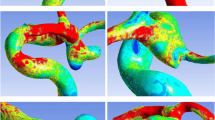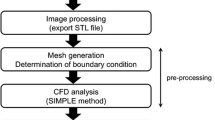Abstract
The purpose of this study is to examine and compare the hemodynamic characteristics of small aneurysms at the same anatomical location. Six internal carotid artery-ophthalmic artery aneurysms smaller than 10 mm were selected. Image-based computational fluid dynamics (CFD) techniques were used to simulate aneurysm hemodynamics. Flow velocity and wall shear stress (WSS) were also quantitatively compared, both in absolute value and relative value using the parent artery as a baseline. We found that flow properties were similar in ruptured and unruptured small aneurysms. However, the WSS was lower at the aneurysm site in unruptured aneurysms and higher in ruptured aneurysms (P < 0.05). Hemodynamic analyses at a single location with similar size enabled us to directly compare the hemodynamics and clinical presentation of brain aneurysms. The results suggest that the WSS in an aneurysm sac can be an important hemodynamic parameter related to the mechanism of brain aneurysm growth and rupture.





Similar content being viewed by others
References
Anayiotos AS, Jones SA, Giddens DP et al (1994) Shear stress at a compliant model of the human carotid bifurcation. J Biomech Eng 116:98–106. doi:10.1115/1.2895710
Beck J, Rohde S, el Beltagy M et al (2003) Difference in configuration of ruptured and unruptured intracranial aneurysms determined by biplanar digital subtraction angiography. Acta Neurochir (Wien) 145:861–865. doi:10.1007/s00701-003-0124-0 discussion 865
Burleson AC, Strother CM, Turitto VT (1995) Computer modeling of intracranial saccular and lateral aneurysms for the study of their hemodynamics. Neurosurgery 37:774–782. doi:10.1097/00006123-199510000-00023 discussion 782–774
Castro MA, Putman CM, Cebral JR (2006) Patient-specific computational modeling of cerebral aneurysms with multiple avenues of flow from 3D rotational angiography images. Acad Radiol 13:811–821. doi:10.1016/j.acra.2006.03.011
Cebral JR, Summers RM (2004) Tracheal and central bronchial aerodynamics using virtual bronchoscopy and computational fluid dynamics. IEEE Trans Med Imaging 23:1021–1033. doi:10.1109/TMI.2004.828680
Cebral JR, Castro MA, Burgess JE et al (2005) Characterization of cerebral aneurysms for assessing risk of rupture by using patient-specific computational hemodynamics models. AJNR Am J Neuroradiol 26:2550–2559
Cebral JR, Castro MA, Appanaboyina S et al (2005) Efficient pipeline for image-based patient-specific analysis of cerebral aneurysm hemodynamics: technique and sensitivity. IEEE Trans Med Imaging 24:457–467. doi:10.1109/TMI.2005.844159
Cebral JR, Castro MA, Putman CM et al (2008) Flow-area relationship in internal carotid and vertebral arteries. Physiol Meas 29:585–594. doi:10.1088/0967-3334/29/5/005
Cheng C, Tempel D, van Haperen R et al (2006) Atherosclerotic lesion size and vulnerability are determined by patterns of fluid shear stress. Circulation 113:2744–2753. doi:10.1161/CIRCULATIONAHA.105.590018
Jou LD, Quick CM, Young WL et al (2003) Computational approach to quantifying hemodynamic forces in giant cerebral aneurysms. AJNR Am J Neuroradiol 24:1804–1810
Kaazempur-Mofrad MR, Wada S, Myers JG et al (2005) Mass transport and fluid flow in stenotic arteries: Axisymmetric and asymmetric models. Int J Heat Mass Transfer 48:4510–4517. doi:10.1016/j.ijheatmasstransfer.2005.05.004
Murayama Y, Nien YL, Duckwiler G et al (2003) Guglielmi detachable coil embolization of cerebral aneurysms: 11 years’ experience. J Neurosurg 98:959–966
Nomura M, Kida S, Uchiyama N et al (2000) Ruptured irregularly shaped aneurysms: pseudoaneurysm formation in a thrombus located at the rupture site. J Neurosurg 93:998–1002
Papaioannou TG, Karatzis EN, Vavuranakis M et al (2006) Assessment of vascular wall shear stress and implications for atherosclerotic disease. Int J Cardiol 113:12–18. doi:10.1016/j.ijcard.2006.03.035
Raghavan ML, Ma B, Harbaugh RE (2005) Quantified aneurysm shape and rupture risk. J Neurosurg 102:355–362
Reneman RS, Arts T, Hoeks AP (2006) Wall shear stress-an important determinant of endothelial cell function and structure-in the arterial system in vivo. Discrepancies with theory. J Vasc Res 43:251–269. doi:10.1159/000091648
Shojima M, Oshima M, Takagi K et al (2004) Magnitude and role of wall shear stress on cerebral aneurysm: computational fluid dynamic study of 20 middle cerebral artery aneurysms. Stroke 35:2500–2505. doi:10.1161/01.STR.0000144648.89172.0f
Shojima M, Oshima M, Takagi K et al (2005) Role of the bloodstream impacting force and the local pressure elevation in the rupture of cerebral aneurysms. Stroke 36:1933–1938. doi:10.1161/01.STR.0000177877.88925.06
Soto O, Löhner R, Cebral J et al (2004) A stabilized edge-based implicit incompressible flow formulation. Comput Methods Appl Mech Eng 193:2139–2154. doi:10.1016/j.cma.2004.01.018
Soustiel JF, Levy E, Bibi R et al (2001) Hemodynamic consequences of cerebral vasospasm on perforating arteries: a phantom model study. Stroke 32:629–635
Steinman DA, Milner JS, Norley CJ et al (2003) Image-based computational simulation of flow dynamics in a giant intracranial aneurysm. AJNR Am J Neuroradiol 24:559–566
Tateshima S, Murayama Y, Villablanca JP et al (2001) Intraaneurysmal flow dynamics study featuring an acrylic aneurysm model manufactured using a computerized tomography angiogram as a mold. J Neurosurg 95:1020–1027
Tateshima S, Murayama Y, Villablanca JP et al (2003) In vitro measurement of fluid-induced wall shear stress in unruptured cerebral aneurysms harboring blebs. Stroke 34:187–192. doi:10.1161/01.STR.0000046456.26587.8B
Tateshima S, Tanishita K, Omura H et al (2007) Intra-aneurysmal hemodynamics during the growth of an unruptured aneurysm: in vitro study using longitudinal CT angiogram database. AJNR Am J Neuroradiol 28:622–627
Tateshima S, Tanishita K, Omura H et al (2008) Intra-aneurysmal hemodynamics in a large middle cerebral artery aneurysm with wall atherosclerosis. Surg Neurol (in press). doi:10.1016/j.surneu.2008.03.035
The International Study of Unruptured Intracranial (1998) Unruptured intracranial aneurysms–risk of rupture and risks of surgical intervention. International Study of Unruptured Intracranial Aneurysms Investigators. N Engl J Med 339:1725–1733. doi:10.1056/NEJM199812103392401
Tobak M, Peake DJ (1982) Topology of three-dimensional separated flows. Ann Rev Fluid Mech 14:61–85. doi:10.1146/annurev.fl.14.010182.000425
Ujiie H, Tachibana H, Hiramatsu O et al (1999) Effects of size and shape (aspect ratio) on the hemodynamics of saccular aneurysms: a possible index for surgical treatment of intracranial aneurysms. Neurosurgery 45:119–129. doi:10.1097/00006123-199907000-00028 discussion 129–130
Ujiie H, Tamano Y, Sasaki K et al (2001) Is the aspect ratio a reliable index for predicting the rupture of a saccular aneurysm? Neurosurgery 48:495–502. doi:10.1097/00006123-200103000-00007 discussion 502–493
Wermer MJ, van der Schaaf IC, Algra A et al (2007) Risk of rupture of unruptured intracranial aneurysms in relation to patient and aneurysm characteristics: an updated meta-analysis. Stroke 38:1404–1410. doi:10.1161/01.STR.0000260955.51401.cd
Wiebers DO, Whisnant JP, Huston J 3rd et al (2003) Unruptured intracranial aneurysms: natural history, clinical outcome, and risks of surgical and endovascular treatment. Lancet 362:103–110. doi:10.1016/S0140-6736(03)13860-3
Yim P, Demarco K, Castro MA et al (2005) Characterization of shear stress on the wall of the carotid artery using magnetic resonance imaging and computational fluid dynamics. Stud Health Technol Inform 113:412–442
Zhao SZ, Xu XY, Hughes AD et al (2000) Blood flow and vessel mechanics in a physiologically realistic model of a human carotid arterial bifurcation. J Biomech 33:975–984. doi:10.1016/S0021-9290(00)00043-9
Author information
Authors and Affiliations
Corresponding author
Rights and permissions
About this article
Cite this article
Chien, A., Tateshima, S., Castro, M. et al. Patient-specific flow analysis of brain aneurysms at a single location: comparison of hemodynamic characteristics in small aneurysms. Med Biol Eng Comput 46, 1113–1120 (2008). https://doi.org/10.1007/s11517-008-0400-5
Received:
Accepted:
Published:
Issue Date:
DOI: https://doi.org/10.1007/s11517-008-0400-5




